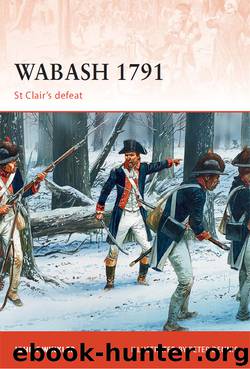Wabash 1791 by John F. Winkler

Author:John F. Winkler
Language: eng
Format: epub
Tags: Wabash 1791: St Clair’s Defeat
ISBN: 9781849088930
Publisher: Osprey Publishing
Published: 2011-10-02T16:00:00+00:00
This monument at Fort Jefferson State Memorial commemorates Fort Jefferson, built at the site of the army’s 12th Camp. Shaped as a square with 114ft sides, the small fort had four corner blockhouses. (Author’s collection)
Joseph Brant attended this church, built in 1785 in his Mohawk village, now Brantford, Ontario. After the battle, the Ohio Indians sent him Richard Butler’s scalp as a rebuke for his failure to join the Indian army. (Courtesy of Her Majesty’s Royal Chapel of the Mohawks)
After a prayer service on Sunday, October 9, St Clair led the army forward on the single path the axmen could cut. Moving through flatter and lower country, the army was able to advance 12 miles in two days. After it reached its 9th Camp on October 10, Oldham’s Kentuckians arrived. St Clair, who considered the militiamen an auxiliary force, ordered them to camp separately, behind the army toward Fort Washington.
On Tuesday, October 11, after advancing 6 miles, the army reached an area where further progress on the surveyor’s line to Kekionga became impossible. A scout’s horse sank 3ft into flooded ground before being rescued. As men searched for routes around Maple Swamp, the army halted at its 10th Camp.
On October 12, Butler found an Indian trail on elevated ground to the east. The army followed it 6 miles to its 11th Camp. That night, the weather turned bad. Since leaving Fort Hamilton, the Americans had marched in dry, cold weather, a relief after the torrential rains. On October 13, however, they awoke to find a layer of ice atop the water in their containers. A day of cold rain followed the first hard frost.
At a spring a mile ahead, St Clair decided to built a second fort, which would be named Fort Jefferson. There, at its 12th Camp, the army stopped on October 13. When Butler gave the usual order to form a square camp, St Clair countermanded the order. Because of the frost, there would no longer be enough food within a camp for the horses and oxen to eat. The army would now camp as St Clair had originally ordered.
On Friday, October 14, the men assembled as usual, a half-hour before daylight, for review in their battalion ranks. Wet after a night sleeping on mud in their porous tents, and cold in their light clothing, they stood in a hard rain in disintegrating shoes as they were told about the work to come. A total of 200 men were to cut trees and build the fort; 700 more were detailed to find food for the horses and oxen. Some searched the woods for places where forage was still available, and led the animals there. Others gathered weeds and carried them back to the camp.
Four days and nights of cold rain followed, as the wet soldiers labored and shivered in their tents. No convoy arrived. On October 17, St Clair announced that there would be only half-rations of flour. The deficit would be offset by more of the almost inedible beef available from the army’s starving oxen.
Download
This site does not store any files on its server. We only index and link to content provided by other sites. Please contact the content providers to delete copyright contents if any and email us, we'll remove relevant links or contents immediately.
| Africa | Americas |
| Arctic & Antarctica | Asia |
| Australia & Oceania | Europe |
| Middle East | Russia |
| United States | World |
| Ancient Civilizations | Military |
| Historical Study & Educational Resources |
The Body: A Guide for Occupants by Bill Bryson(4974)
Liar's Poker by Michael Lewis(3370)
Into Thin Air by Jon Krakauer(3313)
Tuesdays With Morrie by Mitch Albom(2697)
Into the Wild by Jon Krakauer(2582)
The Diamond Cutter by Geshe Michael Roach(2019)
My Dark Places by James Ellroy(1881)
Columbine by Dave Cullen(1817)
Helter Skelter: The True Story of the Manson Murders by Vincent Bugliosi & Curt Gentry(1699)
Extraordinary, Ordinary People by Condoleezza Rice(1468)
Everything in Its Place by Oliver Sacks(1445)
Pilgrim at Tinker Creek by Annie Dillard(1390)
Into the wild by Jon Krakauer(1383)
You Can't Touch My Hair by Phoebe Robinson(1360)
The Girls: Sappho Goes to Hollywood by Diana McLellan(1281)
Dark Towers by David Enrich(1206)
Betrayal by Gregg Olsen(1203)
Call Sign Chaos by Jim Mattis & Bing West(1186)
The Letters of Allen Ginsberg by Allen Ginsberg(1113)
